Chevrolet Silverado: Wheels and Tires / Tire Changing
Removing the Spare Tire and Tools
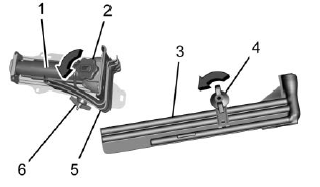
- Jack
- Jack Knob
- Tool Kit
- Wing Nut Retaining Tool Kit
- Wheel Blocks
- Wing Nut Retaining Wheel Blocks
The equipment is under the second row seats, if equipped, or behind the front row seats on regular cab models.
- Turn the knob on the jack counterclockwise to lower the jack head to release the jack from its holder.
- Turn the wing nut counterclockwise to remove the wheel blocks and the wheel block retainer.
- Turn the wing nut used to retain the storage bag and tools counterclockwise to remove it.
Use the jack handle extensions and the wheel wrench to remove the underbody-mounted spare tire.

- Spare Tire (Valve Stem Pointed Down)
- Tire/Wheel Retainer
- Hoist Cable
- Hoist Assembly
- Hoist Shaft
- Jack Handle Extensions
- Wheel Wrench
- Spare Tire Lock (If Equipped)
- Hoist Shaft Access Hole
- Hoist End of Extension Tool
- Open the spare tire lock cover on the bumper and use the ignition key to
remove the spare tire lock (8). To remove the spare tire lock, insert the ignition
key, turn, and pull straight out.
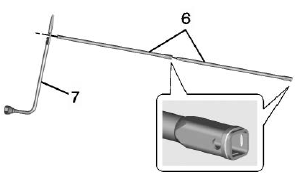
- Assemble the wheel wrench (7) and the two jack handle extensions (6), as
shown.

Spare Tire Cable (If Equipped)
- If the vehicle is equipped with a spare tire cable disconnect the cable
from the attachment on the frame by unclipping it from the frame attachment
bracket.
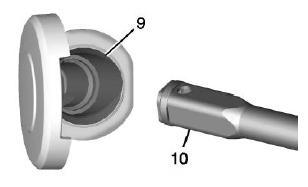
- Insert the hoist end (open end) (10) of the extension through the hole (9)
in the rear bumper.
Do not use the chiseled end of the wheel wrench.
Be sure the hoist end of the extension (10) connects to the hoist shaft. The ribbed square end of the extension is used to lower the spare tire.
- Turn the wheel wrench counterclockwise to lower the spare tire to the ground. Continue to turn the wheel wrench until the spare tire can be pulled out from under the vehicle.
- Pull the spare tire out from under the vehicle.
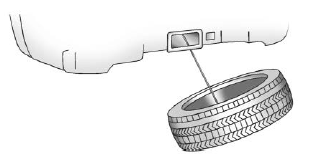
- Tilt the tire toward the vehicle with some slack in the cable to access
the tire/wheel retainer.

1500 Models

All Other Models
Tilt the retainer and pull it through the center of the wheel along with the cable and spring.
- Put the spare tire near the flat tire.

- If equipped with a spare tire cable remove the cable from the spare tire by passing the clip through the looped end of the cable.
Removing the Flat Tire and Installing the Spare Tire
Use the following pictures and instructions to remove the flat tire and raise the vehicle.
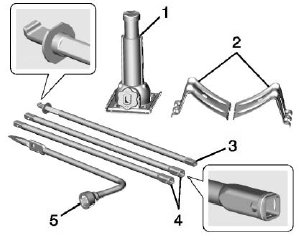
- Jack
- Wheel Blocks
- Jack Handle
- Jack Handle Extensions
- Wheel Wrench
The tools you will be using include the jack (1), the wheel blocks (2), the jack handle (3), the jack handle extensions (4), and the wheel wrench (5).
- Do a safety check before proceeding. See If a Tire Goes Flat.

- If the vehicle has wheel nut caps, loosen them by turning the wheel wrench
counterclockwise.
If the vehicle has a center cap with wheel nut caps, the wheel nut caps are designed to stay with the center cap after they are loosened. Remove the entire center cap.
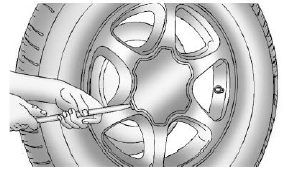
If the wheel has a smooth center cap, concealing access to the wheel nuts, place the chisel end of the wheel wrench in the slot on the wheel, and gently pry it out.
If the wheel’s center cap does not conceal the wheel nuts, the center cap may remain during wheel removal. If the removed wheel is to be stowed in the hoist, the cap needs to be detached from the wheel. Access the wheel from the back side, and use a jack handle extension to push out the center cap.
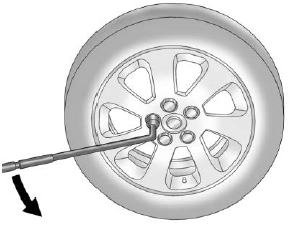
- Use the wheel wrench and turn it counterclockwise to loosen the wheel nuts.
Do not remove the wheel nuts yet.
Warning
To avoid personal injury and vehicle damage, disable the power assist steps before using a jack or placing an object under the vehicle. See Power Assist Steps 0 32.
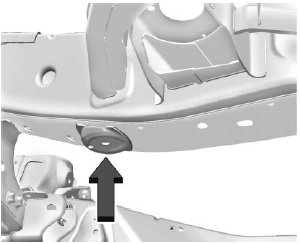
Front Position — 1500 Models

Front Position — All Other Models
- If the flat tire is on the front of the vehicle, position the jack under
the bracket attached to the vehicle's frame, behind the flat tire, as shown.

Rear Position — 1500 Models
- If the flat tire is on the rear, position the jack under the rear axle about
5 cm (2 in) inboard of the shock absorber bracket.
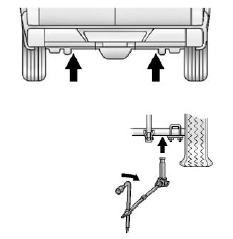
Rear Position All Other Models
For all other models, position the jack under the rear axle between the spring anchor and the shock absorber bracket.
If a snow plow has been added to the front of the vehicle, lower the snow plow fully before raising the vehicle.
Make sure that the jack head is positioned so that the rear axle is resting securely between the grooves that are on the jack head.
Warning
Getting under a vehicle when it is lifted on a jack is dangerous. If the vehicle slips off the jack, you could be badly injured or killed. Never get under a vehicle when it is supported only by a jack.
Warning
Raising the vehicle with the jack improperly positioned can damage the vehicle and even make the vehicle fall. To help avoid personal injury and vehicle damage, be sure to fit the jack lift head into the proper location before raising the vehicle.
- Turn the wheel wrench clockwise to raise the vehicle. Raise the vehicle
far enough off the ground so there is enough room for the spare tire to fit
under the wheel well.
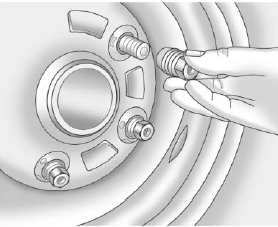
- Remove all the wheel nuts and take off the flat tire.
Warning
Rust or dirt on a wheel, or on the parts to which it is fastened, can make wheel nuts become loose after time. The wheel could come off and cause a crash. When changing a wheel, remove any rust or dirt from places where the wheel attaches to the vehicle. In an emergency, a cloth or a paper towel can be used; however, use a scraper or wire brush later to remove all rust or dirt.
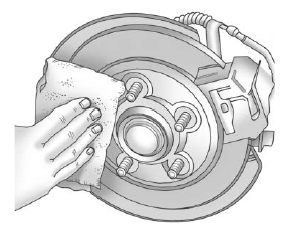
- Remove any rust or dirt from the wheel bolts, mounting surfaces, and spare wheel.
- Install the spare tire.
Warning
Never use oil or grease on bolts or nuts because the nuts might come loose. The vehicle's wheel could fall off, causing a crash.
- Put the wheel nuts back on with the rounded end of the nuts toward the wheel.
- Tighten each wheel nut by hand. Then use the wheel wrench to tighten the nuts until the wheel is held against the hub.
- Turn the wheel wrench counterclockwise to lower the vehicle. Lower the jack
completely.
Warning
If wheel studs are damaged, they can break. If all the studs on a wheel broke, the wheel could come off and cause a crash.
If any stud is damaged because of a loose-running wheel, it could be that all of the studs are damaged. To be sure, replace all studs on the wheel. If the stud holes in a wheel have become larger, the wheel could collapse in operation. Replace any wheel if its stud holes have become larger or distorted in any way. Inspect hubs and hub‐piloted wheels for damage. Because of loose running wheels, piloting pad damage may occur and require replacement of the entire hub, for proper centering of the wheels. When replacing studs, hubs, wheel nuts or wheels, be sure to use GM original equipment parts.
Warning
Wheel nuts that are improperly or incorrectly tightened can cause the wheels to become loose or come off. The wheel nuts should be tightened with a torque wrench to the proper torque specification after replacing. Follow the torque specification supplied by the aftermarket manufacturer when using accessory locking wheel nuts. See Capacities and Specifications for original equipment wheel nut torque specifications.
Caution
Improperly tightened wheel nuts can lead to brake pulsation and rotor damage. To avoid expensive brake repairs, evenly tighten the wheel nuts in the proper sequence and to the proper torque specification. See Capacities and Specifications for the wheel nut torque specification.
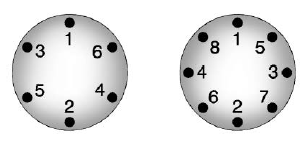
- Tighten the nuts firmly in a crisscross sequence, as shown, by turning the wheel wrench clockwise.
For vehicles with dual wheels, have a technician check the wheel nut tightness of all wheels with a torque wrench after the first 160, 1 600 and 10 000 km (100, 1,000 and 6,000 mi). Repeat this service whenever you have a tire removed or serviced. See Capacities and Specifications.
When reinstalling the regular wheel and tire, also reinstall either the center cap, or bolt-on hub cap, depending on what the vehicle is equipped with. For center caps, place the cap on the wheel and tap it into place until it seats flush with the wheel. The cap only goes on one way. Be sure to line up the tab on the center cap with the indentation on the wheel. For bolt-on hub caps, align the plastic nut caps with the wheel nuts and then tighten by hand. Then use the wheel wrench to tighten.
Storing a Flat or Spare Tire and Tools
Warning
Storing a jack, a tire, or other equipment in the passenger compartment of the vehicle could cause injury. In a sudden stop or collision, loose equipment could strike someone. Store all these in the proper place.
Warning
Failure to follow these tire storage instructions carefully could result in personal injury or property damage if the hoist cable fails or if the tire comes loose. Make sure the tire is stored securely before driving.
Caution
Storing an aluminum wheel with a flat tire under your vehicle for an extended period of time or with the valve stem pointing up can damage the wheel. Always stow the wheel with the valve stem pointing down and have the wheel/tire repaired as soon as possible.
Caution
The tire hoist can be damaged if there is no tension on the cable when using it. To have the necessary tension, the spare or road tire and wheel assembly must be installed on the tire hoist to use it.
Warning
An improperly stored spare tire could come loose and cause a crash. To avoid personal injury or property damage, always store the spare tire when the vehicle is parked on a level surface.
Store the tire under the rear of the vehicle in the spare tire carrier.

- Spare Tire (Valve Stem Pointed Down)
- Tire/Wheel Retainer
- Hoist Cable
- Hoist Assembly
- Hoist Shaft
- Jack Handle Extensions
- Wheel Wrench
- Spare Tire Lock (If Equipped)
- Hoist Shaft Access Hole
- Hoist End of Extension Tool
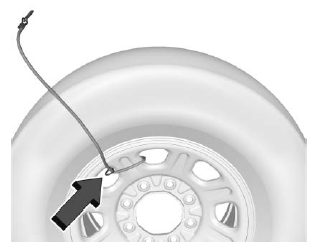
- Spare Tire Cable (If Equipped)
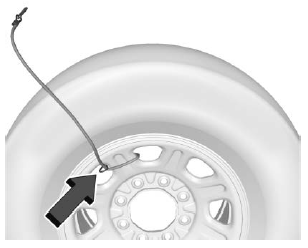
- If equipped with a spare tire cable, reinstall the cable to the spare wheel by looping the cable around a wheel vent window then pass the clip end of the cable through the looped end. The excess cable wire should be on the valve stem side of the spare tire.
- Put the tire on the ground at the rear of the vehicle with the valve stem pointed down, and to the rear.
- Pull the cable and spring through the center of the wheel. Tilt the wheel
retainer plate down and through the center wheel.
Make sure the retainer is fully seated across the underside of the wheel.
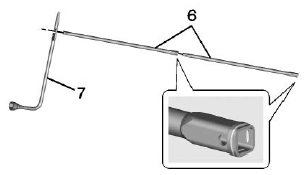
- Attach the wheel wrench (7) and extensions (6) together, as shown.
Caution
Use of an air wrench or other power tools with the hoist mechanism is not recommended and could damage the system. Use only the tools supplied with the hoist mechanism.

- Insert the hoist end (10) through the hole (9) in the rear bumper and onto
the hoist shaft.
Do not use the chiseled end of the wheel wrench.
- Raise the tire part way upward. Make sure the retainer is seated in the
wheel opening.
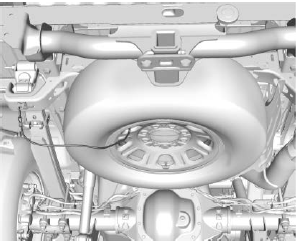
- If equipped with a spare tire cable, orient the cable by rotating the spare tire so that the cable is by the frame attachment location.
- Raise the tire fully against the underside of the vehicle by turning the
wheel wrench clockwise until you hear two clicks or feel it skip twice. You
cannot overtighten the cable.
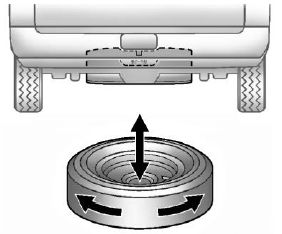
- Make sure the tire is stored securely. Push, pull, and then try to turn
the tire. If the tire moves, use the wheel wrench to tighten the cable.

If equipped with a spare tire cable, reattach the clip to the frame attachment bracket. Note that there may be slack in the cable.
Repeat this tightness check procedure when checking the spare tire pressure according to the scheduled maintenance information or any time the spare tire is handled due to service of other components.
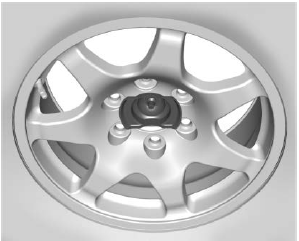
Correctly Stored
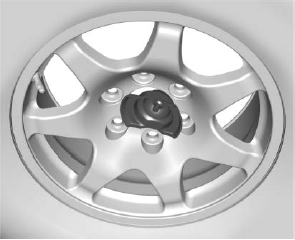
Incorrectly Stored
- Reinstall the spare tire lock, if the vehicle has one.
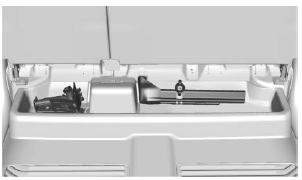
Return the jack and tools to their original location in the vehicle. See “Removing the Spare Tire and Tools.”
 If a Tire Goes Flat
If a Tire Goes Flat
It is unusual for a tire to blowout while driving, especially if the tires are
maintained properly. If air goes out of a tire, it is much more likely to leak out
slowly...
 Full-Size Spare Tire
Full-Size Spare Tire
If this vehicle came with a full-size spare tire, it was fully inflated when
new, however, it can lose air over time. Check the inflation pressure regularly...
Other information:
Chevrolet Silverado 2019-2025 Owners Manual: Add-On Electrical Equipment
Warning The Data Link Connector (DLC) is used for vehicle service and Emission Inspection/Maintenance testing. See Malfunction Indicator Lamp (Check Engine Light). A device connected to the DLC — such as an aftermarket fleet or driver-behavior tracking device — may interfere with vehicle systems...
Chevrolet Silverado 2019-2025 Owners Manual: Head-Up Display (HUD)
Warning If the HUD image is too bright or too high in your field of view, it may take you more time to see things you need to see when it is dark outside. Be sure to keep the HUD image dim and placed low in your field of view. If equipped with HUD, some information about the operation of the vehicle is projected onto the windshield...
Categories
- Manuals Home
- 4th Generation Silverado Owners Manual
- 4th Generation Silverado Service Manual
- Driver Information Center (DIC) (Midlevel and Uplevel)
- Lower Anchors and Tethers for Children (LATCH System)
- Power Release Tailgate
- New on site
- Most important about car
Keys (Key Access)
Warning
Leaving children in a vehicle with the ignition key is dangerous and children or others could be seriously injured or killed. They could operate the power windows or other controls or make the vehicle move. The windows will function with the keys in the ignition, and children or others could be caught in the path of a closing window. Do not leave children in a vehicle with the ignition key.

